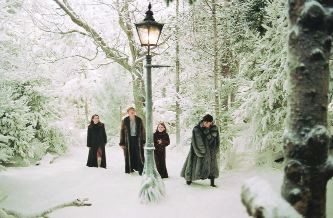Talk to the animals

If you grew up on C. S. Lewis’s Narnia books, you won’t be disappointed in The Chronicles of Narnia: The Lion, the Witch and the Wardrobe, the first in a projected series. It’s visually rich and imaginative, and emotionally stirring. Director Andrew Adamson and his co-writers (Ann Peacock, Christopher Markus and Stephen McFeely) have hewn closely to Lewis’s 1950 children’s novel, yet the movie never feels like a slavish adaptation, as some of the Harry Potter movies do.
But then The Lion has a less complicated plot. Four London schoolchildren, sent to a Victorian mansion in the countryside during the Blitz, walk into a wardrobe in one of its many rooms and discover that the back opens into an enchanted world called Narnia, where animals converse and the wicked White Witch holds sway. The appearance of the four Pevensie kids, “sons of Adam and daughters of Eve” who are fated to sit on the Narnian throne, signals the end of the witch’s wintry, tyrannical reign. (Spring hasn’t been seen in a century.) And the great lion Aslan, the Witch’s opposite number, has returned to help the forces of good wrest away her control.
The book is the most beloved of modern Christian allegories; it climaxes with Aslan’s crucifixion (he barters his own life for that of one of the children—a Judas whose need of redemption stands for humankind’s) and his resurrection. Far from attempting to minimize the Christian iconography, the filmmakers dive into it, embracing the ideas and framing the images that make the story so elementally powerful.
Aslan’s death is staged magnificently, and the cruelty of the gloating ice queen (Tilda Swinton, putting her chilly presence to good use for once) is deeply upsetting. When she and her minions abandon the lion’s bound body to the stone table on which he sacrificed himself, the Pevensie girls, Susan (Anna Popplewell) and Lucy (Georgie Henley), weep over him like a latter-day Mary and Martha. The boys, Peter (William Moseley), the eldest, and Edmund (Skandar Keynes), whose poor judgment allied him at first with the witch, do battle against the witch’s armies. The boys’ junior-size medieval armor calls to mind the Crusades.
Adamson’s choice to spend some time establishing the World War II setting is smart for two reasons. Readers of the book accept Edmund’s appalling conduct (he betrays his siblings to the White Witch for the promise of a limitless supply of Turkish Delight) as a requisite of the plot, and because he’s a little boy one doesn’t linger on it—especially since Aslan forgives him and Edmund proves his worth in the battle. The film traces his sullenness and willfulness to the absence of his father (who’s in the Air Force), a loss that he, as the younger boy, feels most acutely of the four children. This plot element gives his behavior a dramatic rationale and makes his character more affecting. (As Edmund, Skandar Keynes makes it easy for us to read the character’s bruised feelings.) At the same time, the movie tacitly parallels the fight for Europe—the last indisputably righteous war—with the struggle to save Narnian civilization.
In general, the interaction of the human actors with the talking animals (voiced by such distinguished actors as Liam Neeson and Rupert Everett) is extremely successful. In fact, there’s hardly a scene from the book that Adamson and his collaborators fail to realize. Occasionally the script sounds a contemporary note inappropriately, as when the Fox meets the Pevensies’ suspicions with the assurance, “I’m one of the good guys.“ But those slip-ups are rare.
Taking his cue from the Lord of the Rings movies, Adamson doesn’t hesitate to make the dark parts of the story truly dark. The Wolves that operate as the White Witch’s secret police are terrifying (something parents of small children might want to consider.) Jim Broadbent contributes a delightful cameo as the professor who owns the house where the Pevensies have taken up wartime residence, and who surprises them by finding Lucy’s tale of Narnia (she’s the first of the four to discover the snowy wood at the end of the wardrobe) entirely plausible when the children’s impulse is to dismiss it as the work of an overactive childish imagination.
The story is mostly Lucy’s. Luckily, Adamson found nine-year-old Georgie Henley, an instinctual actor whose wide-eyed buoyancy and emotional transparency are enthralling. Adamson needs to make the rest of the Narnia movies—at least, those that revolve around the Pevensies—while Henley is still young enough to play Lucy.





